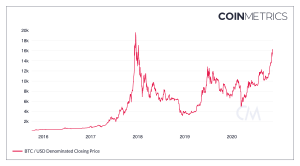Crypto: Functionality and Future
Written by: Marko Ilic
Throughout the 2010s, cryptocurrency has risen from a fad to an increasingly adopted investment field totaling a $2 trillion market capitalization. The most prominent digital currency, otherwise known as coins, includes the pioneer Bitcoin, with others like Ethereum, Cardano, Litecoin, and Dogecoin. Despite different underlying code, energy cost, and intended purposes, all coins share certain characteristics: they run on blockchain technology, use encryption to verify the authenticity of assets, and are stored through digital wallets. The allure of crypto, another name for the bubbling currency, lies in its decentralized nature, as it provides a different mode of currency in opposition to central-bank controlled fiat money. Coins are not distributed through banks or reserves and are mined through energy costly hardware, ensuring that the value of stable-coins does not disproportionally decrease. With crypto’s decentralized quality as the appeal for the asset, it raises a myriad of issues related to regulation, criminal activity, and financial independence.
History
While attempts to create digital currency throughout the late 20th century proved unsuccessful, they laid the groundwork for an independent virtual asset which had a value independent of conventional fiat currencies. In 2009, a pseudonym by the name of Satoshi Nakamoto described the prototype of blockchain technology and its subsequent currency, Bitcoin. The pseudonym, likely a team of programmers, created the coin later that year, where it experienced multiple system deficiencies, including a major 2010 hack involving 184 billion Bitcoin. As the coin saw its first years as an open currency, it constantly endured rigorous coding modifications and system changes, aimed at securing the safe passage of coins through transactions, wallet safety, and authentication through proof-of-work ledgers. In 2011, 10,000 Bitcoin was swapped in exchange for 2 pizzas, marking the first time in the coin’s history that it is traded in return for globally acknowledged asset, the US dollar. As the coin gains traction through online forums like Reddit, in addition to the adoption of its value by various countries and companies, namely Microsoft in 2014 as a method of purchasing online games, competing coins like Litecoin and Ethereum emerged.
Appeal & Function
Cryptocurrencies’ virtual nature allows owners to hold vast amounts of monetary value in digital wallets, databases where their value is stored and protected through encryption, which are specifically designed to protect from security breaches. The danger of physical money being counterfeit, lost, or destroyed is absent with cryptocurrency, as the blockchain uses proof-of-work ledgers which show how much energy has been expended on a certain coin, showing whether it is authentic and the amount of transactions incurred upon that coin. In addition, the coin’s fluctuating value differs from other forms of digital currency like PayPal and CashApp, which use fiat, centrally-backed currencies as a third-party to determine the value. While crypto has an attached value to fiat currency, its value fluctuates with complete independence, typically with much higher volatility than conventional investments like stocks, bonds, and precious metals. As shown in figure 1, the historical patterns of Bitcoin show large, sudden spikes, typically followed by steep declines which produce new bases, with the pattern repeating with gradually more pronounced spikes and falls. As of November 2021, Bitcoin has risen over 10,600% since September 2011, with the price rising from $5.40 to over $60,000. The large risk attached to cryptocurrencies has compelled many retail traders on mobile exchanges like Robinhood and Coinbase to trade in a highly risky, impuslive manner, a credit to the assets’ largely meme-based culture. Meme-coins have evolved such as Shiba-inu and Dogecoin, which have experienced even greater volatility than ‘stablecoins’ like Ethereum and Bitcoin, which have historically followed safer patterns of price fluctuation. In October 2021, Shiba Inu, a recently created “memecoin” shot up 777% in merely 30 days, wheras Bitcoin rose 30% in the same timeframe. While many long-established investors like Charlie Munger and Ray Dalio call crypto “worthless”, a new generation of prospective retail investors, in addition to many hedge funds, have taken increased notice and liking to the highly volatile, yet potentially fruitful asset.
Figure 1

Bitcoin All-Time Chart
Source: CoinMetrics
Future
Many countries, namely China, India, and Iran, have already banned cryptocurrency, citing money laundering and tax evasion as major concerns. Despite widespread pushback, many countries are embracing the modern currency, albeit with regulations in place. Regulations governing cryptocurrencies will cover the safe handling of crypto through bank control, tax services, and the exchange of crypto for conventional fiat currency. While certain regulations have the ability to create the crypto market increasingly safe and efficient, many owners are offput with the idea of bank and government interference. The appeal for many crypto-enthusiasts initially was the complete independence in which the market operated, without influence from conventional currency. Regardless, specific regulation of cryptocurrency seems to be inevitable, as the exploding quantity of owners and ever-rising prices will continually grow the market, necesittating government outlines on how the asset will be approached. With government regulation looming, the risk of a crypto crash increases, as any major change in the way that cryptocurrency is handled will result in catastrophic price declines for the entire market. A crypto crash, which is a an extremely quick, and similarly drastic drop of value, can be incurred through investor uncertainty, regulatory woes, or black swan events – anything ranging from another pandemic to nuclear war.
Conclusion
Cryptocurrency’s ever-growing market has its core values — a decentralized coin with little regulation on a collision course with the largest governments in the world, who seek to grow their control on the murky guidelines of the crypto market. Any large modification to the functionality and appeal of crypto could result in increased volatility, while creating an uncertain future for the direction of the relatively new currency. The way in which cryptocurrency will behave in the upcoming months and years will determine its long-term fate as a legitimate asset and investment.
Figure 2

Various Regulatory Approaches by Countries
Source: blockstreetHQ
References and Sources
Livni, E. (2021, January 30).What’s next for Crypto Regulation. Retrieved November 15, from https://www.nytimes.com/2021/01/30/business/dealbook/crypto-regulation-blockchain.html
Maidan, L. (2021, November 18). The Future of Crypto, Mass Adoption, and Regulation. Retrieved November 18, from https://www.businessinsider.com/crypto-investing-bitcoin-altcoins-future-mass-adoption-regulation-webinar-watch-2021-11
Kolhatkar, S. (2021, October 6). The Challenges of Regulating Cryptocurrency.. Retrieved November 15, from https://www.newyorker.com/business/currency/the-challenges-of-regulating-cryptocurrency
Martucci, B.. (2021, May 18). What is Cryptocurrency – How it works, History & Bitcoin Alternatives.. Retrieved November 15, from https://www.moneycrashers.com/cryptocurrency-history-bitcoin-alternatives/
Lee, A. (2021, May 12). The History of Cryptocurrency: Bitcoin’s Long, Strange Trip to Best-Performing Asset of the Decade. Retrieved November 16, from https://www.esquire.com/lifestyle/money/g36290032/history-of-cryptocurrency/?utm_source=google&utm_medium=cpc&utm_campaign=arb_ga_esq_d_bm_g36290032&gclid=Cj0KCQiA-qGNBhD3ARIsAO_o7ynqZ